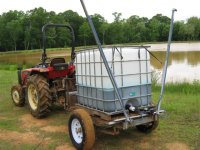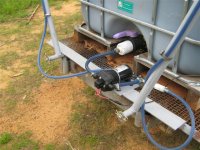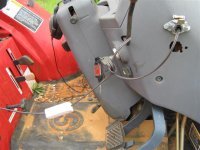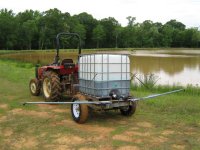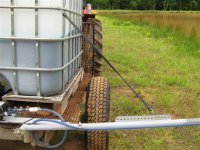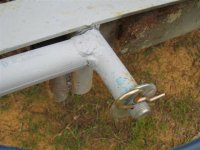EddieWalker
Epic Contributor
My license arrived on Saturday. It's really just a piece of yellow paper that has my name printed on it, with some information on what I can buy. I must admit to being disappointed in seeing it, but then again, nobody wasted any money creating it.
I spoke with a few people, plus took notes on suggestions from here. I decided to go with an initial application of 2,4-D. Figuring it my rate of application, mixture and coverage was just about more then my brain could handle. I went with one gallon per 100 gallons of water at a very slow speed.
A few months ago, I bought a 275 gallon, square tank that had been used for a red colored syrup of some kind. I washed it out and put it on my ATV trailer. Then I saw some sprayer tips for sale at Northern Tool that spray 16 feet out. I put one at the end of each boom for a total spray width of 31 feet. The boom was a challenge, but the more I thought about it, the simpler it became. When I built it, I think I had it down to the very simplest design possible. I also want it to be quick and easy to take apart for storage. The pump is a 12v unit that I turn on and off with an inline 110v switch that hangs down near my ankle. The switch is really simple and easy to use. I turn it on, and I have spray coming out instantly. I turn it off, and it's not pumping any more.
While buying the two gallons of 2,4-D I noticed some dye to show up where I sprayed. Since I don't know what I'm doing, I bought it so that I could see where I'd been and hopefully avoid spraying the same area twice.
During the week, I had been playing around with the sprayer and water in the tank. How far did it spray and what was it like to operate it. This proved to be very helpful and allowed me to know a little bit of what to expect before the real thing.
This morning, I sprayed. It went really smoothly, so that was a shock. I didn't know what to expect, but mostly it was just a challenge to spray the grass and keep it out of the trees. The width was also a challenge to get it through the trees. Fortunately, it's very quick and easy to stop the pump.
Now it's a matter of time until it take effect. Any thoughts on how long it takes to work?
Thank you,
Eddie
I spoke with a few people, plus took notes on suggestions from here. I decided to go with an initial application of 2,4-D. Figuring it my rate of application, mixture and coverage was just about more then my brain could handle. I went with one gallon per 100 gallons of water at a very slow speed.
A few months ago, I bought a 275 gallon, square tank that had been used for a red colored syrup of some kind. I washed it out and put it on my ATV trailer. Then I saw some sprayer tips for sale at Northern Tool that spray 16 feet out. I put one at the end of each boom for a total spray width of 31 feet. The boom was a challenge, but the more I thought about it, the simpler it became. When I built it, I think I had it down to the very simplest design possible. I also want it to be quick and easy to take apart for storage. The pump is a 12v unit that I turn on and off with an inline 110v switch that hangs down near my ankle. The switch is really simple and easy to use. I turn it on, and I have spray coming out instantly. I turn it off, and it's not pumping any more.
While buying the two gallons of 2,4-D I noticed some dye to show up where I sprayed. Since I don't know what I'm doing, I bought it so that I could see where I'd been and hopefully avoid spraying the same area twice.
During the week, I had been playing around with the sprayer and water in the tank. How far did it spray and what was it like to operate it. This proved to be very helpful and allowed me to know a little bit of what to expect before the real thing.
This morning, I sprayed. It went really smoothly, so that was a shock. I didn't know what to expect, but mostly it was just a challenge to spray the grass and keep it out of the trees. The width was also a challenge to get it through the trees. Fortunately, it's very quick and easy to stop the pump.
Now it's a matter of time until it take effect. Any thoughts on how long it takes to work?
Thank you,
Eddie
